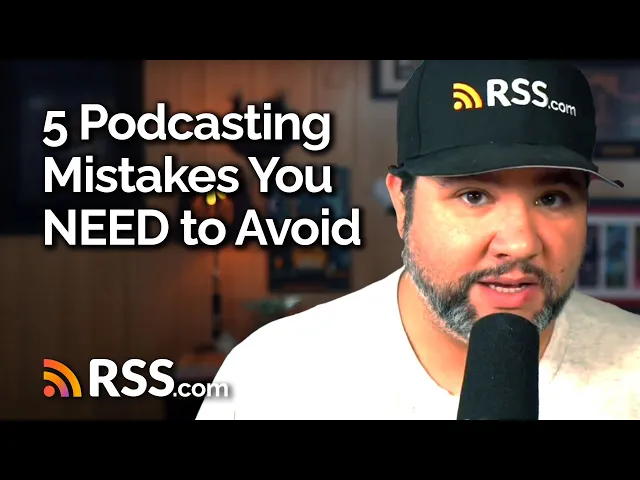Learning something new comes with mistakes. But some can be avoided if you listen to those who’ve been there.
After 13 years of podcasting and coaching hundreds of podcasters, our evangelist Joe Casabona has seen patterns. Below are the five most common mistakes and how to fix them.
Prefer to watch? Check out his video on our YouTube Channel:
1. Targeting Everyone Instead of a Specific Audience
“My podcast is for everyone!”
Joe hears this all the time. And he gets why people think this way. More people means more listeners, right?
Wrong.
When you try to appeal to everyone, you appeal to no one.
It’s like opening a baseball stadium in the middle of nowhere and hoping fans from across the country will show up. They won’t.
Instead, pick a side. Get specific. Make a promise to a particular audience and deliver on it.
Compare these two approaches:
- “I host a cooking podcast.”
- “I host a cooking podcast for families with three or more kids and two working parents.”
See the difference? The second one speaks directly to people who will actually listen and tell their friends.
What makes you different from every other podcast in your category? Specificity is the answer.
2. Not Distributing Your Podcast Everywhere
Years ago, being on Apple Podcasts was enough.
Not anymore.
Today, you need to be on Apple Podcasts, Spotify, and YouTube (now one of the biggest podcast platforms in the U.S.).
Plus there are other apps where your listeners hang out.
If you’re not everywhere, you’re losing listeners. Period.
People won’t hunt for your show. If they can’t find you on their preferred platform, they’ll listen to something else instead.
RSS.com makes this easy. We autosubmit your show to as many platforms as possible and guide you through manual submissions for the rest.
We even have YouTube integration through Pod Viz technology, so you get engaging video content without shooting actual video.
Check out all the podcast directories you should submit your podcast to.
3. Lack of a Clear Call to Action
How many times have you heard this at the end of a podcast?
“Check out the show notes, share with a friend, fill out our feedback form, rate us on iTunes, review us on Spotify, join our mailing list, and don’t forget about our sponsors!”
That’s too many things.
When you give people too many options, especially listeners who aren’t fully paying attention, they do nothing.
The fix? One clear call to action. That’s it.
Then repeat it three times: at the beginning, middle, and end of your episode.
Don’t wait until the end when half your audience has already left.
Start with a cold open that teases your main takeaway, then give your call to action. Mention it again in the middle when it’s relevant. Close with it at the end.
People need to hear things multiple times before they take action. And that action needs to be super easy.
Learn more about creating effective calls to action in your podcast.
4. Neglecting Transcripts for Accessibility and SEO
When I started podcasting, transcripts were expensive and rare. Today, there’s no excuse not to have them.
Transcripts aren’t just for accessibility (though that alone is reason enough).
They help listeners search for specific information making them great for boosting your podcast SEO!
And, they give you content to repurpose into blog posts and newsletters as well.
RSS.com provides free automated transcripts on any paid plan.
When you publish an episode, we generate the transcript and integrate it perfectly into your RSS.com website.
Making your podcast more accessible and discoverable? That’s a no-brainer.
5. Delaying Monetization Strategies
“I’ll just launch first and figure out how to monetize later.”
“Once I hit X downloads, sponsors will come to me.”
If you’re serious about your podcast, you need to think about monetization from day one.
Nobody opens a retail store without a plan to make money. Your podcast shouldn’t be different.
We’re not saying your show has to be profitable immediately. Have a plan to make money starting from the beginning.
RSS.com offers multiple monetization options right out of the gate:
You don’t have to sit around hoping sponsors will find you.
Build your monetization strategy into your launch plan.
Bonus Mistake: Ignoring the Power of an Email List
This one ties all five mistakes together.
Not having an email list is a huge missed opportunity.
Here’s why:
- Your newsletter requires you to make a clear promise to subscribers.
- You need a strong call to action to get people to sign up.
- You can use transcripts to give readers a preview of each episode.
- And, it provides another monetization channel.
Use whatever email service provider works best for you. (Joe likes Kit because it has RSS feed integration that automatically sends emails when new episodes are published.)
Start building your list now. Make it your primary call to action.
Also see: 6 Reasons Why Your Podcast Needs an Email List
Quick Recap
Let’s run through these mistakes one more time:
- Saying you’re for everyone. Pick a specific audience, make a promise, and deliver for them.
- Not being everywhere. You can’t rely on just Apple Podcasts and Spotify anymore. Be where your listeners are.
- No clear call to action. Choose one action and repeat it throughout your episode.
- Not having transcripts. They improve accessibility, SEO, and give you repurposing options. RSS.com generates them automatically.
- Not thinking about monetization sooner. Have a plan from the start. Use the tools RSS.com provides to make money from day one.
- Bonus: Not having an email list. Build your list and make it part of your podcast strategy.
Avoiding these five mistakes will set you up for success. Your podcast deserves to be heard, and fixing these issues will help you reach the right people.
Ready to start your podcast? Click here to launch today!
